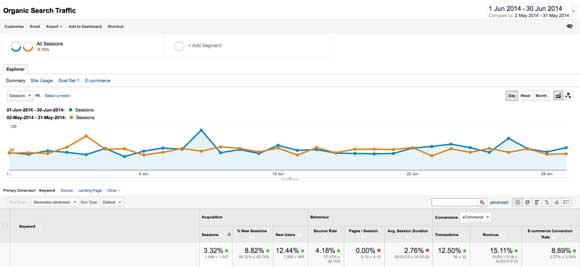Getting Around Duplicate Product Descriptions
If your site has duplicate content — if you use the same wording in more than one place or copy text from elsewhere on the web — then you’re setting yourself up for trouble with Google. Because duplicate content is associated with spam, low quality sites and black hat SEO, it lowers search engine rankings.
You should be aware that duplicate product descriptions have the same negative effect as duplicate blog entires or web page content. It’s not the biggest factor in rankings; on a well built site, content strategy is the largest influence on Google rankings. However, in our experience, removing duplicate content can increase online sales by 10% or more.

Google will detect duplicate content if two URLs point to the same page, and that’s something that we’ll correct in our initial site overhaul. However, duplicate product descriptions remain a common problem, too. They make it harder to rank for long tailed keywords, and using all-original content can improve conversion rates, as well.
When do we see duplicate product descriptions?
Duplicate product descriptions are fairly common, and they’re an easy mistake to make. We most often see them associated with similar products on the same e-commerce site or copied from the manufacturer’s site by resellers. It’s only natural to find the right wording and then use it wherever it applies, right? Well, unfortunately, that doesn’t fly with Google’s ranking algorithm. If you have landing or sales pages for slight product variations such as colour and size, and the pages use some of the same wording, then it can cause a big problem with your SEO.
A case study
We have a StewArt client who was guilty of both mistakes: they were using product descriptions from the manufacturer’s site, and they were using separate pages for different sizes, too. They had site-wide internal and external duplication. To Google’s search algorithm, this made their site look low quality and derivative.
What did we do? We:
- 1. Switched them over to drop-down menus
- 2. Had custom content written for the product descriptions
- 3. Set up Google Publisher
Drop-down Menus
Almost every e-commerce site sells variations on products, whether it’s different shoe colours, different dress sizes or features that can be added on. This client was no exception, and they had placed each variation onto its own sales page. The first thing we did was restructure the e-commerce set-up so that it used pull-down menus rather than separate pages for minor variations on the products. Fewer sales pages is easier on you, easier on your customer and easier for Google’s spiders to catalogue.
Original Content
Once we had consolidated the products, we asked our client to rewrite the product descriptions, aiming the copy directly at their market and their customer base. That’s good marketing as well as good SEO. The original content can be written by you (our client), or contracted out to a content writer or copywriting agency.
Google Publisher
Finally, we set up Google Publisher. Adding a Publisher markup tag (rel=â€publisherâ€) to a website tells Google that the content published there is written by the same publisher managing the Google+ business page. This also helps to protect a site’s ranking; if someone plagiarises your unique content, your site will still rank higher due to the publisher setup.
Results
In the screen shot below, you can see that the client improved their commerce conversion by 8.9%. Similarly, transactions were up by 12.5%. This was entirely due to the steps described above; the only work we did for this client during the time period on the chart was eliminating duplicate content.
Long tailed keywords are keywords that are highly specific, and they are linked to much higher than average conversion rates. Previously, our client’s rankings for long tailed keywords had dropped off. After fixing the duplicate content issue, their ranking for long tailed keywords increased dramatically, thus conversion and sales increased as well.
So, to summarise:
Strategies:
- 1. We replaced separate pages for variations on items with consolidated pages and drop-down menus.
- 2. We replaced copied, repetitive content with custom-written, unique content in the product descriptions
- 3. We engaged Google Publisher throughout the site.
Results:
- ✓ Greatly improved rankings for long tailed keywords
- ✓ Commerce conversion rate +8.9%
- ✓ Transactions +12.5%


